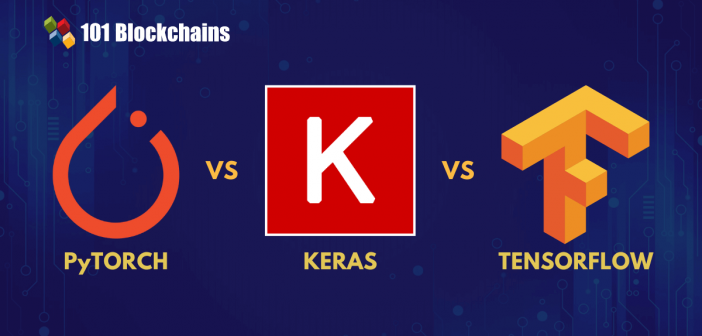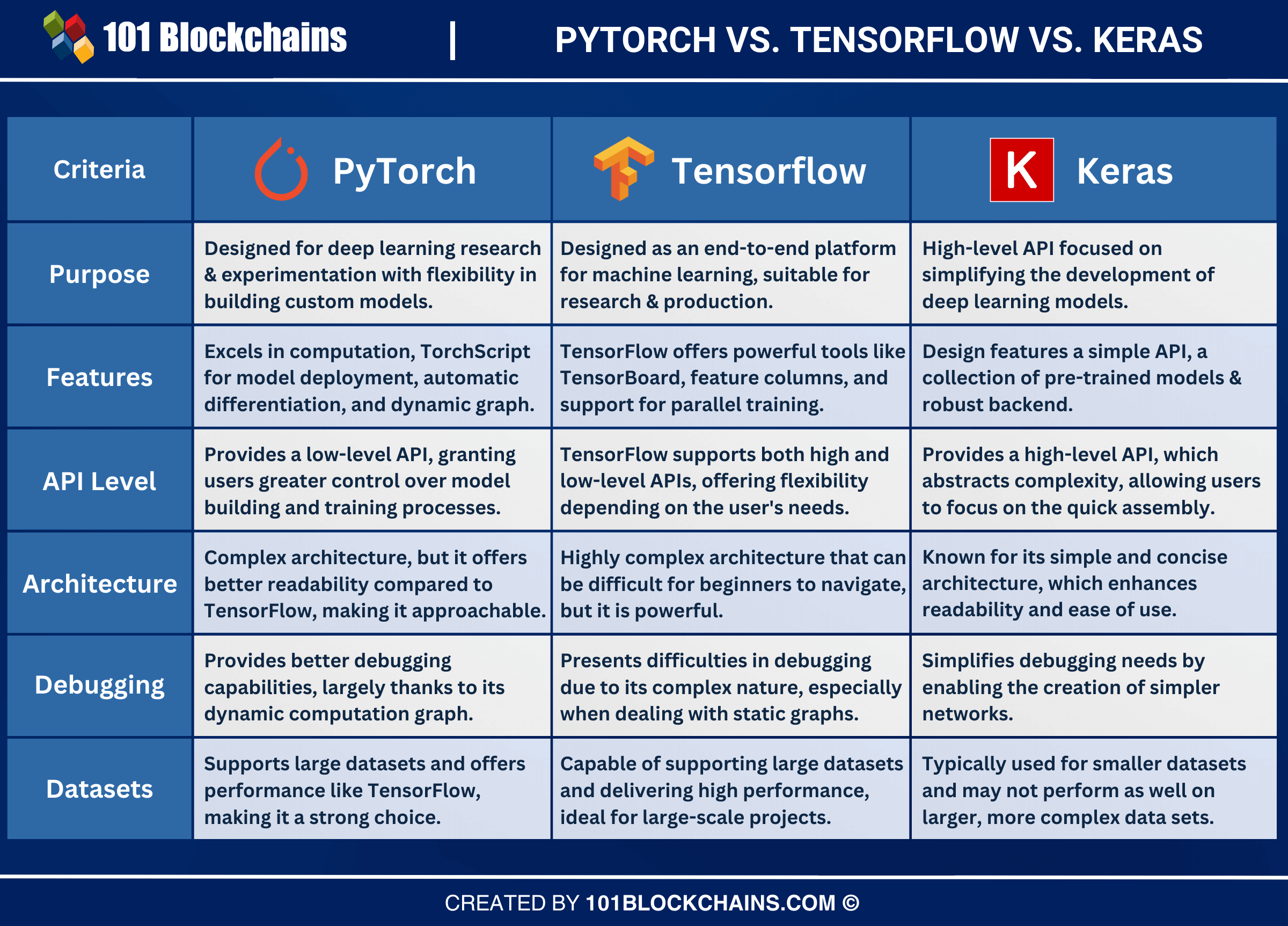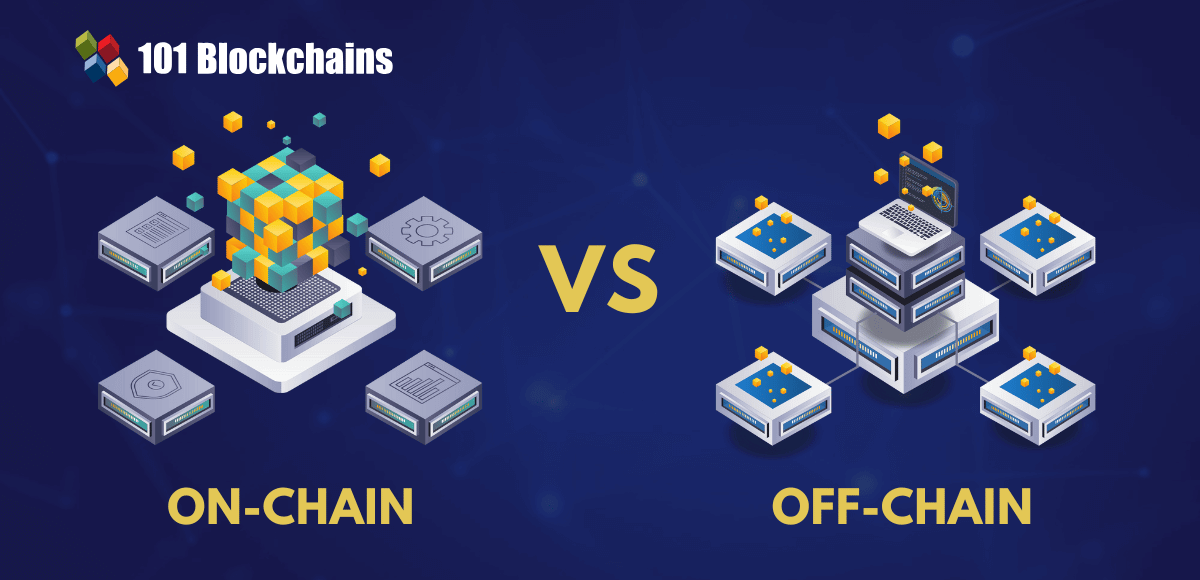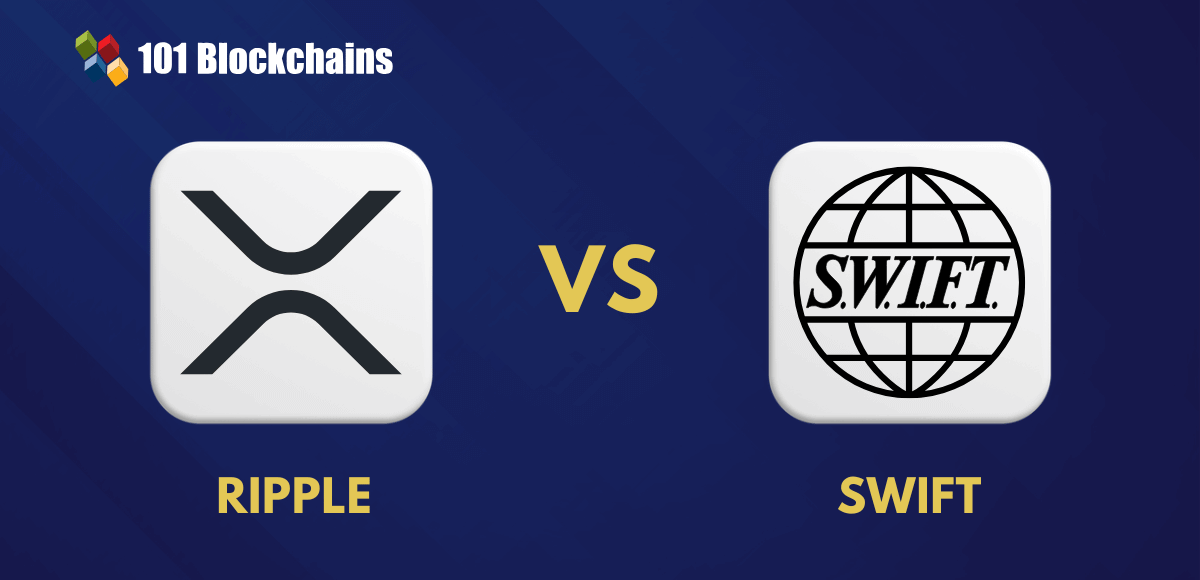Learn how blockchain truly works, master key definitions, and uncover what makes smart contracts so "smart." Dive into the fundamentals, gain valuable insights, and start your blockchain journey today!

- Comparisons
James Howell
- on August 27, 2024
PyTorch vs. TensorFlow vs. Keras: Key Differences
Deep learning frameworks help in easier development and deployment of machine learning models. The frameworks support AI systems with learning, training models, and implementation. The three most prominent deep learning frameworks right now include PyTorch, Keras, and TensorFlow.
You would need a PyTorch vs. TensorFlow vs. Keras comparison to find the best way forward for your artificial intelligence projects. AI researchers and practitioners use the frameworks according to their needs by leveraging their unique strengths in different areas. Machine learning practitioners and engineers need frameworks to reduce the burden of technicalities associated with programming ML and deep learning models.
For example, machine learning frameworks help implement models without digging deeper into the mathematical foundations of the algorithms. Let us unravel the differences between these frameworks on the basis of certain crucial aspects to help you make the right decision.
What are TensorFlow, PyTorch, and Keras?
Deep learning and machine learning are important subsets of artificial intelligence that help power different AI use cases. The frameworks can help in supporting different applications such as speech recognition, decision-making, language translation, and object detection. Before you dive into a TensorFlow vs. Keras vs. PyTorch comparison, it is important to learn more about the frameworks and their advantages. The comparison can help you avoid the confusion between these frameworks and find the right pick for your AI projects.
-
Overview of TensorFlow
TensorFlow is an important end-to-end open-source deep learning framework that has been created by Google. It is popular for extensive documentation and training support, multiple abstraction levels, scalable production and deployment alternatives, and compatibility with different platforms. The PyTorch vs. TensorFlow comparison draws attention to the fact that TensorFlow is a popular neural network library.
It is useful for data flow programming in a broad collection of tasks. The framework offers the assurance of better scalability and flexibility. You can find different types of stable toolkits and libraries with TensorFlow alongside the support of a thriving community. It offers the benefits of accessibility and deployment of machine learning models on different platforms.
-
Overview of PyTorch
PyTorch is the latest entry among machine learning frameworks. It was created by Facebook AI research group and became open-source in 2016. The capabilities of PyTorch have helped it earn recognition for efficiency, simplicity, and flexibility. You can find a better impression of the Keras vs. PyTorch difference with insights into the capabilities of PyTorch.
It can help engineers with the most efficient capabilities for debugging and experimentation with different algorithms. The other prominent advantages of PyTorch include GPU acceleration and flexibility for integration with Python. PyTorch serves many other promising features, such as dynamic computational graphs, ease of use, simplicity, and efficient memory usage.
-
Overview of Keras
Keras is a popular high-level open-source neural network API. It is tailored for deep learning and offers a user-friendly interface alongside flexibility for using code across different systems. The Keras vs. TensorFlow comparison also draws attention to the compatibility of Keras with TensorFlow. The framework was integrated and adopted for TensorFlow, thereby ensuring accessibility to TensorFlow users.
In addition, it can also work effectively along with the Microsoft Cognitive Toolkit or CNTK. The primary focus of Keras revolves around deployability, debugging speed, ease of maintenance, and elegance and conciseness of code. It enables the use of a smaller and more readable codebase that supports easier iteration.
Take your first step towards learning about artificial intelligence through AI Flashcards
What are the Differences between TensorFlow, PyTorch, and Keras?
The comparison between TensorFlow, PyTorch, and Keras is an essential requirement to figure out which option is the best for you. However, it is difficult to differentiate the three frameworks due to the availability of powerful features in each framework. Here is an overview of the comparison between TensorFlow, PyTorch, and Keras based on different factors.
-
Core Features
The most important factor in answering queries like “Which is better, Keras or PyTorch or TensorFlow?” focuses on the core features of the frameworks. A review of the core features of TensorFlow, PyTorch, and Keras can help identify their power for machine learning projects.
TensorFlow offers promising features such as TensorBoard, parallel training, and feature columns. It also facilitates easier training on CPU and GPU. TensorBoard serves as an interactive visualization toolset that helps you understand, debug, and optimize TensorFlow programs.
Feature columns in TensorFlow are high-level abstractions that help in transformation of raw data into formats tailored for machine learning. In addition, TensorFlow also supports parallel training that involves distributed computing, which can reduce training times.
Keras stands out in the PyTorch vs. TensorFlow vs. Keras debate with its diverse range of features. It offers a user-friendly API that enables better prospects for familiarizing with deep learning. Keras also offers backend support with the strength of Theano, TensorFlow, and Microsoft CNTK. It is a high-level API that can support faster development of models within a few lines of code. On top of it, Keras offers a collection of pre-trained models that you can use for different machine-learning tasks.
PyTorch is also a powerful framework tailored for machine learning and deep learning workloads. The notable features of PyTorch include Tensor computation, dynamic graph computation, TorchScript, and automatic differentiation. PyTorch offers a multidimensional array in the form of a Tensor that could work on GPUs to achieve faster computation.
The framework also leverages dynamic computation graphs that can enable flexibility in development and modification of models. TorchScript is a trusted feature for serialization of PyTorch models that ensures compatibility with C++ environments and readiness for production. PyTorch also leverages automatic differentiation alongside gradient computation for simplification of neural network backpropagation and training.
Understand the actual potential of AI and the best practices for using AI tools with the AI For Business Course.
-
API Level
Another important factor in the comparison between TensorFlow, PyTorch, and Keras is the API level of the frameworks.
The PyTorch vs. TensorFlow comparison places TensorFlow at an advantage with the facility of high-level and low-level APIs.
On the other hand, PyTorch is a low-level API that supports working directly with array expressions. Therefore, it has become more popular for academic research as well as deep learning applications that require optimization of custom expressions.
Keras is a high-level API that can run on Theano, TensorFlow, and CNTK. It has become a favorite pick for machine learning researchers and developers for its easier usability and simple syntax that can ensure faster development.
-
Architecture
The architecture of machine learning frameworks also serves as a crucial factor for comparing them. It can help you with the TensorFlow vs. Keras vs. PyTorch debate to find out which framework offers better usability. TensorFlow has the most complex architecture and can be difficult to use for beginners.
On the other hand, PyTorch also has a complex architecture and creates setbacks for readability, especially for beginners.
Keras stands out as the best pick in terms of architecture for its simplicity. On top of it, it is concise and offers better readability.
-
Debugging Capabilities
Debugging is a crucial requirement of a machine learning framework to ensure that you create ML models free of errors. The Keras vs. TensorFlow comparison suggests that TensorFlow might not be suitable for projects that require a comprehensive assessment of projects before deployment. TensorFlow presents formidable setbacks for conducting debugging.
Keras also follows along the lines of TensorFlow in terms of debugging, albeit with a different perspective. It is a simple network, implying that you may not need debugging in most cases.
PyTorch emerges as the winner for its impressive debugging capabilities as compared to Keras and TensorFlow.
Enroll now in the ChatGPT Fundamentals Course and dive into the world of prompt engineering with practical demonstrations.
-
Datasets
The next vital factor that you must consider in a Keras vs. PyTorch comparison is the type of datasets they support. Interestingly, TensorFlow and PyTorch are on the same page in terms of the supported datasets. The two frameworks support large datasets and ensure high performance.
On the other hand, Keras is suitable for running only smaller datasets.
Here is an overview of the differences between TensorFlow, PyTorch, and Keras.

Final Words
The search for answers to questions like “Which is better, Keras or PyTorch or TensorFlow?” would help you learn about their distinct strengths. You can find the ideal machine learning framework by leveraging different aspects such as the architecture, datasets, level of APIs, and debugging capabilities.
These factors can serve as ideal benchmarks for comparing the frameworks to determine the best pick among them. Interestingly, TensorFlow, PyTorch, and Keras are the most popular frameworks used by machine learning researchers and developers. Learn more about their unique functionalities, advantages, and limitations to determine which framework fits your project requirements perfectly.







